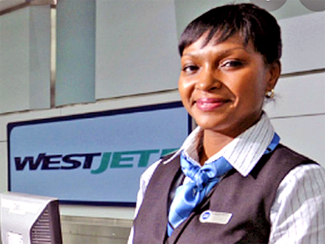UP, UP AND AWAY
WestJet airport agents use card check fast track to join Unifor

THE WESTJET WORKERS SAID “YES” JUST ONCE and they got their union. It doesn’t happen everywhere.
Workers who want to join unions in B.C., Nova Scotia, Saskatchewan, Manitoba and most occupations in Ontario have to say “yes” again in a mandatory certification vote, to confirm that when they signed their union card they really meant it.
The 531 Westjet airport agents didn’t face this double jeopardy. They are federally-regulated workers with the right to union certification by way of a “card check”—where a bargaining unit is automatically certified once a set number of employees sign membership cards.
The Canada Labour Relations board certified Unifor as the sole bargaining agent for for 320 airport agents in Calgary and 211 in Vancouver on May 20, after declaring that more than half the workers at the two locations had signed membership cards.
‘One-stop’ model
Historically, Canadian governments accepted a signed union card as proof enough that a worker wanted join a particular union. This ‘one-stop’ model is known as “Card Check”.
However, in more recent decades, conservative governments began to replace the one-step Card Check model with the two-step mandatory ballot model.
The ballot model requires the union to first submit evidence of substantial employee support in order to obtain a right to a certification vote, which the union must then win in order to obtain the legal right to represent the workers in collective bargaining.
Mandatory certification votes give employers a chance to interfere in the certification process with campaigns of fear and intimidation to make workers second guess their original decision to join a union. The recent failed union vote by Amazon workers in Alabama is an example of how such employer campaigns can work.
Organizing in a pandemic
However, even with card check, organizing a union is challenging—never more so than in the middle of a pandemic.
Unifor Organizing Director Kellie Scanlan says Unifor organizers had to “switch and pivot” in their campaign once covid restrictions denied them access to the workplace. She says the WestJet win “really shows the power of online organizing.”
“We started to do online zoom meetings, to use social media much more than we had in the past and we really got to the phones. Plus, we really relied on the workers who were remaining in those workplaces to carry the union message."
The union also developed an online membership card, a new payment system that was online for collecting fees that the labor board requires for each card.
“We’ve done this sort of organizing tactics before, but with COVID-19 they took on a new urgency for us to sort of really get a handle on those tools—and we did," says Scanlan.
More business than family
Westjet likes to promote itself as the kind of workplace where employees are more like family members than workers paid by the hour. Scanlon says the workers decision to join a union acknowledges a different reality.
“I think what the workers understood was that regardless of that family sort of culture, when it came to the bigger scheme of things, they just weren’t at the table. And even though they had an employee association of sorts, it didn’t have teeth and they needed to be able to sit at a table with a legally binding collective agreement.
Unifor president Jerry Dias says the whole dynamic of the Westjet model changed when it was sold to the multi-billion dollar Onyx corporation.
“Onyx operates different than the old WestJet for sure,” says Dias. “I mean, one of the first things that happened was unilaterally outsourcing of so many jobs. Workers started asking, ‘will Onyx have the same commitment to us as the original WestJet?’.
Dias adds that the growth of Westjet from a scrappy regional carrier to a major airline meant the whole family culture thing just stopped working.
Additional reading from the Canadian Foundation for Labour Rights
Key Policy Reforms for Improving Bargaining Unit Certifications
- 30 -













Add new comment